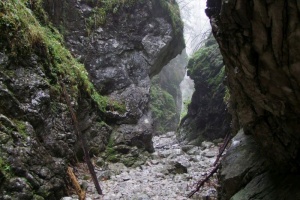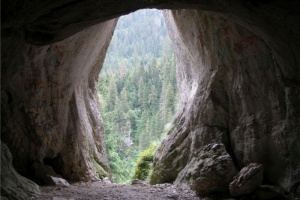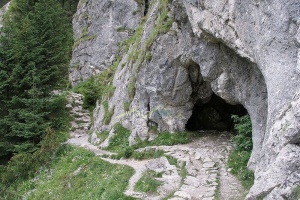Caves in Zakopane
Pisana Cave (Written Cave) in the Kościeliska Valley
The cave is located in the Kościeliska Valley inside the Pisana Rock. An underground stream flows out of it which is also an underground stream outflow from the Kraków Gully, and partially a branch of the Kościelisko Stream. Due to the water running through it, the cave is difficult to explore. In the cave itself traces of treasure hunters have been found. Moreover, the cave is associated with the legend of the sleeping knights.
The cave was discovered by speleologists in 1959 however it had been know earlier by sheep shepherds. Inside the cave record-breaking depths have been attained (377 m, 620 m, 640 m). The corridors inside the cave are more than 2000 meters long, including an icefall and a number of waterfalls.
Mroźna Cave (Icy Cave), the Małej Łąki Valley, slopes of Małołączniak
The cave was discovered in 1938 by Stanisław Zwoliński. It is about 400 meters long (the whole length of the cave is lit by electrical lights). It is one of the most beautiful caves in the Tatra Mountains. In summer it is made available to the mass visit from 10.00 to 15.00. Tickets can be purchased at the entrance to the cave.
Smocza Cave (Dragon’s Cave), the Kraków Gully
The cave is worth visiting as part of a trip through picturesque, made available for tourist part of the Krakow Gully. Despite its short length, it is necessary to use a torch while walking through its corridors.
Obłazkowa Cave, Zakopane – the Kościeliska Valley
The cave is located in the Tatra Mountains, in the Kościeliska Valley, in the massif of Raptawicki Peak. Carved in Jurassic limestone, 1150 m above sea level, its total length of corridors is about 120 meters.
Czarna Cave (Black Cave), Zakopane – the eastern slope of the Kościeliska Valley
It is a cretaceous cave, in the Polish part of the Western Tatras, on the eastern slope of the Kościeliska Valley, in the massif of Organy. One of the longest (6th place) and deepest (7th place) of all in the Polish Tatra Mountain caves (between 1961 and 1976 the longest), considered to be the most spacious Polish cave.
Mylna Cave (Erroneous Cave), Zakopane – the Kościeliska Valley
Mylna Cave lies in the central part of the Kościeliska Valley, inside Raptawicka Peak. This is perhaps the most interesting cave made available for tourists in the Polish Tatra Mountains.
Dziura Cave (Hole Cave), Zakopane
This cave is situated in the Ku Dziurze Valley. This is the closest cave to Zakopane that can be explored. It is about 20 meters deep and 60 meters long. Despite the fact that it is not big, it is a great place for taking a walk, practicing caving ... and a filmset for "chilling" cave scenes. This is largely due to the fact that it has got a “window” in the roof, through which you can slide down on line while the film crew enters the cave through a convenient opening.
Raptawicka Cave, Zakopane – the Kościeliska Valley
The Raptawicka Cave is relatively small, with a length of 150 m, however it can be visited independently. It is located in the Kościeliska Valley. To get to the inside of the cave one must climb down a ladder that runs down a hole that is 3 meters in diameter. Raptawicka Cave consists of two halls. It is connected with Mylna cave.
Miętusia Cave, Zakopane – the Miętusia Valley
Currently Mietusia Cave has the largest horizontal extent of about 1,150 m of all Polish caves. Due to the low position of the hole and water obstacles is a cave typically visited during the winter period. Only a small part of it, that is until “the Doorstep of the Martyrs”, is suitable for attending. It is a very popular cave among tourists, as well as a good place for caving and speleology.
W Szarym Cave (I the Grey Cave), Zakopane – the Miętusia Valley
This cave is located at the top of Szary Źleb (the Grey Gully) next to “the bunker” on the left side of Skalka (the Rock). One can reach it via trail leading to Małołączniak and then all the way to “the bunker”. From there it the cave is only 10 meters up and 10 meters to the left. However, exploring might turn out to be difficult because of the presence of large amount of soil from the surface.





